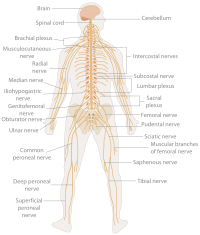
Photo from wikipedia
Vascular network is first generated by vasculogenesis and angiogenesis. The vessel diameters are later modified by vascular flow, which is called remodeling process. Various theoretical models were proposed for this… Click to show full abstract
Vascular network is first generated by vasculogenesis and angiogenesis. The vessel diameters are later modified by vascular flow, which is called remodeling process. Various theoretical models were proposed for this remodeling process to explain vascular patterns in vivo. However, if we fully understand the mechanism of pattern formation, we should be able to generate the vascular pattern from scratch. In the present study, we utilized a microdevice to generate perfusable vascular network (Kim et al., 2013), and established a long-term perfusion method using braille display. Synthetic vasculature first starts as an irregular network. Then the endothelial cells in the microdevice exhibits remodelling process. Unused part of the vascular bed gradually disappears, resulting in one thick blood vessel in the devise. First, we formulated a model to explain the early phase of network formation. Time-lapse observation of first 12 hours of culture revealed the endothelial cell dynamics. The cultured cells seldom moved but extended long protrusions, and stochastic collisions of the protrusion and cell body established the connections between cells. Effect of neighbouring cell on formation and elongation of protrusion is not observed. Based on these findings, we use stochastic model with experimentally measured parameter to reproduce the initial phase of meshwork formation in this culture system. Next, we established amodel to reproduce the remodelling process in a microdevice. We utilized a simple model in which vessel wall change its position for optimized share stress value. We implemented the vessel wall change by phase field method, and the Stokes flow by MAC method. The numerical simulation reproduces pruning process observed in the microdevice, and final thickness of remaining vasculature can be obtained analytically.
Journal Title: Mechanisms of Development
Year Published: 2017
Link to full text (if available)
Share on Social Media: Sign Up to like & get
recommendations!